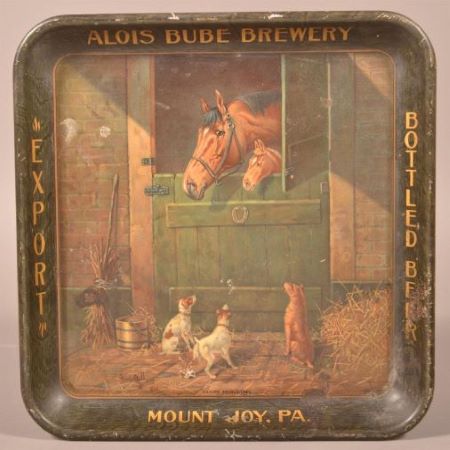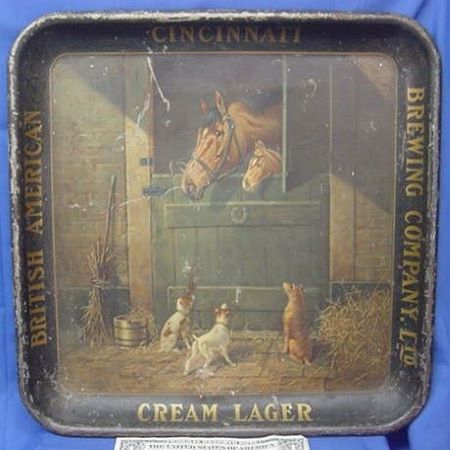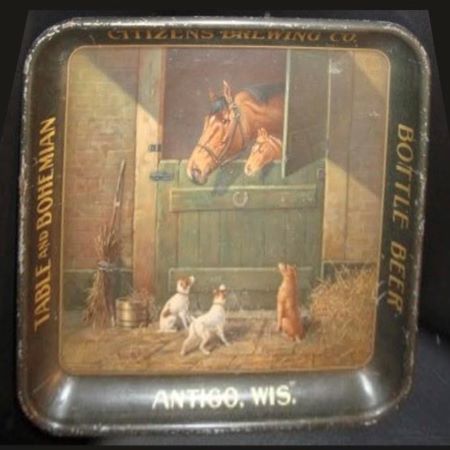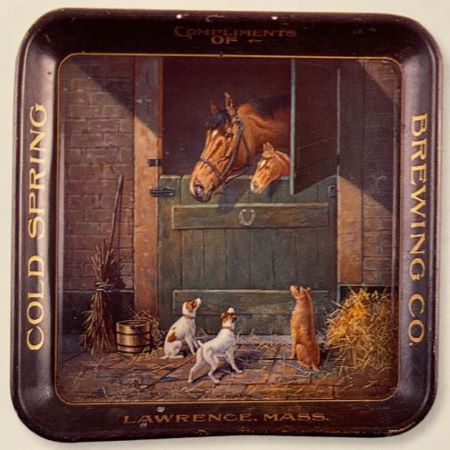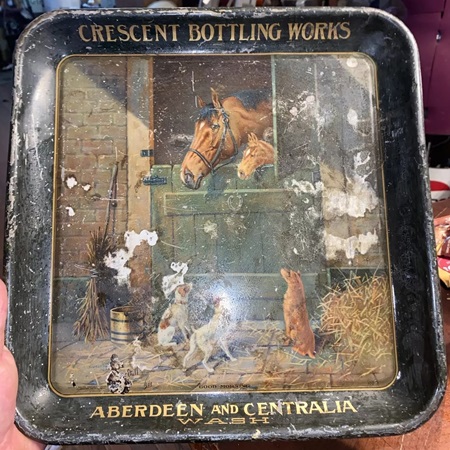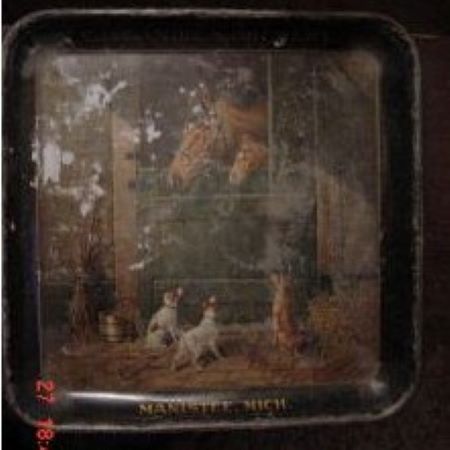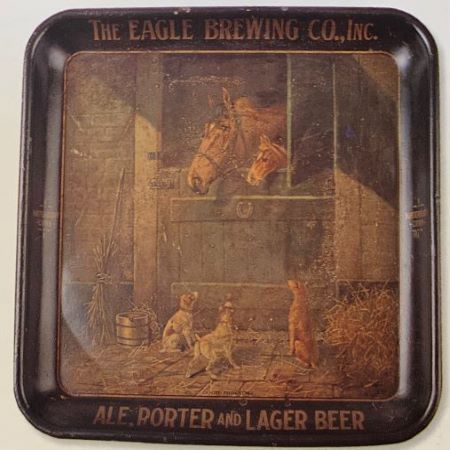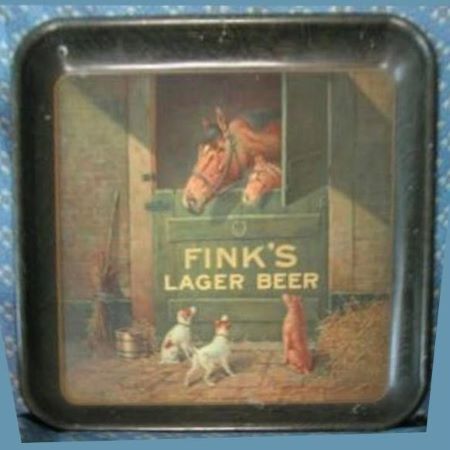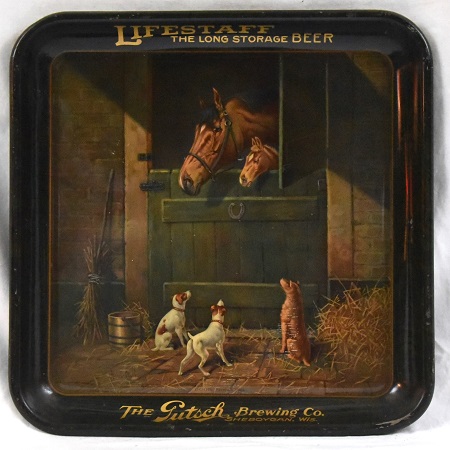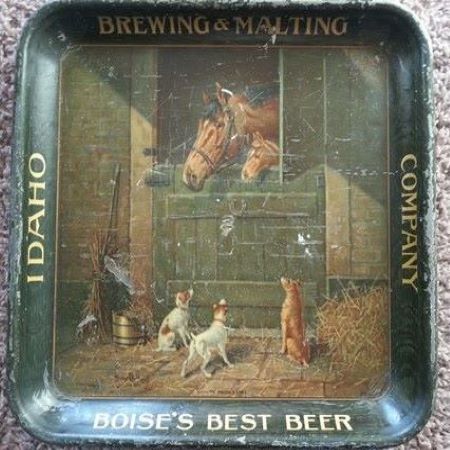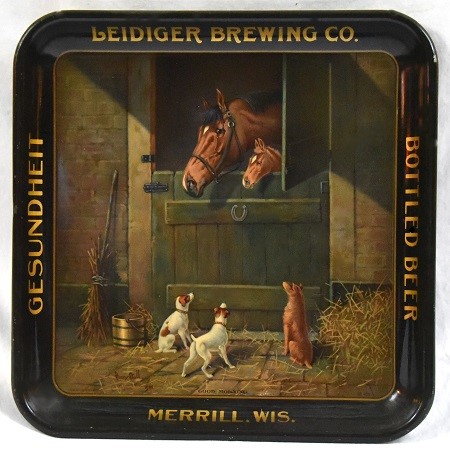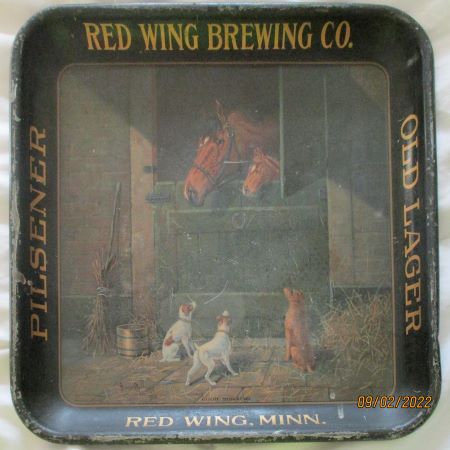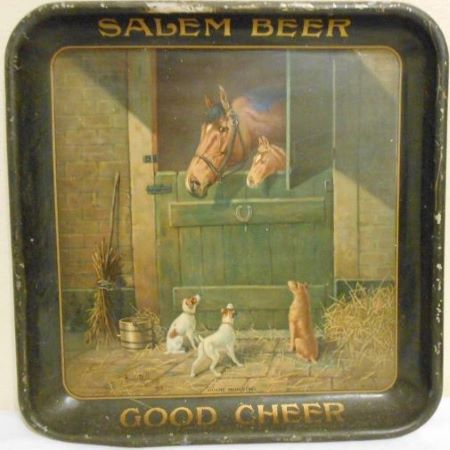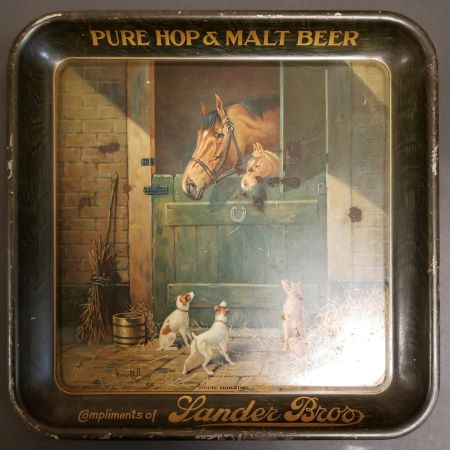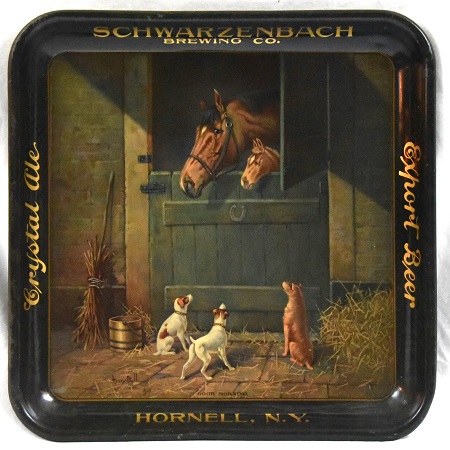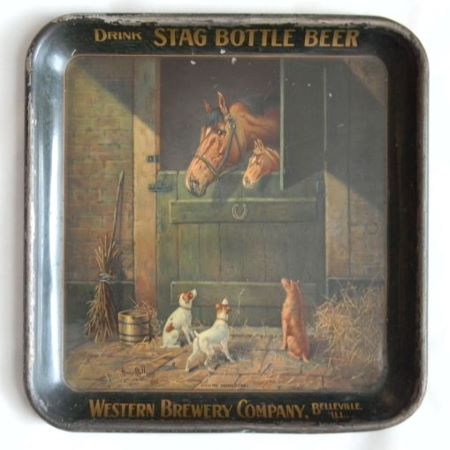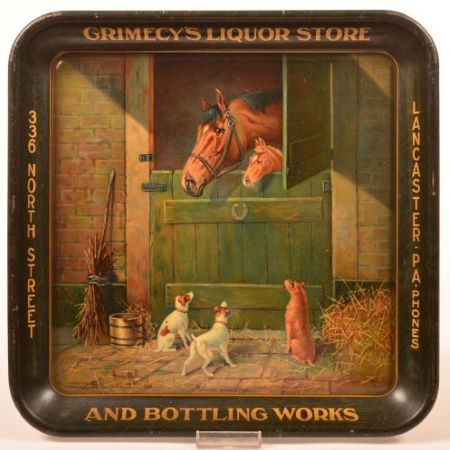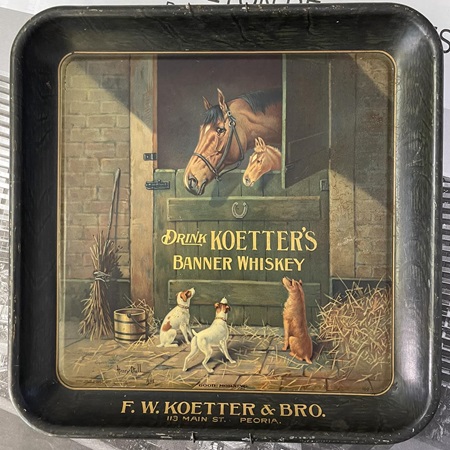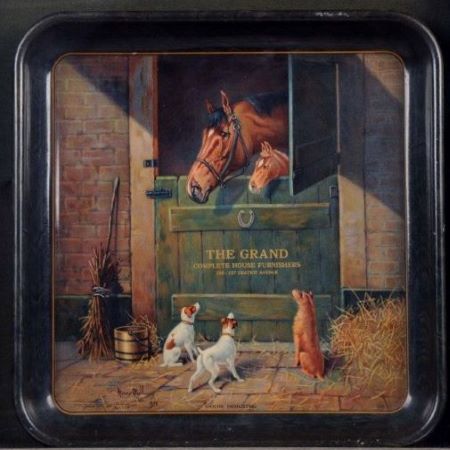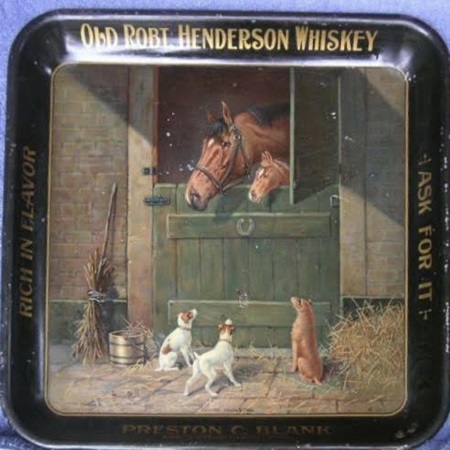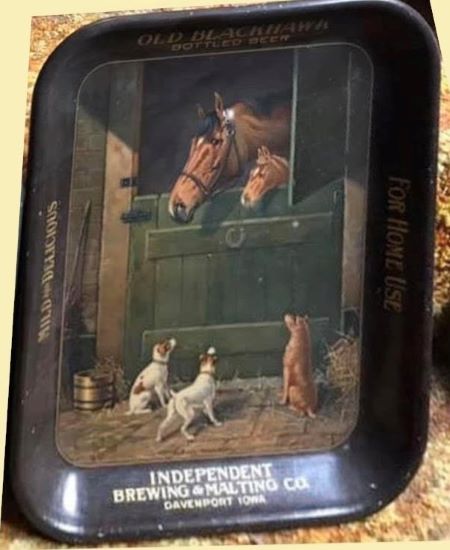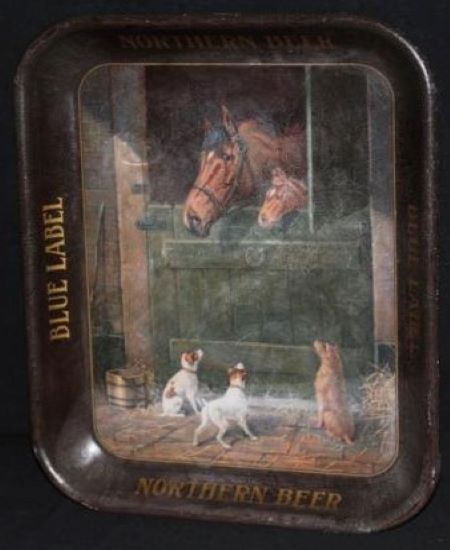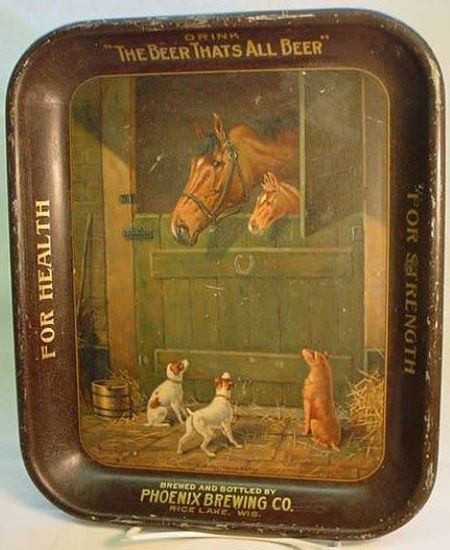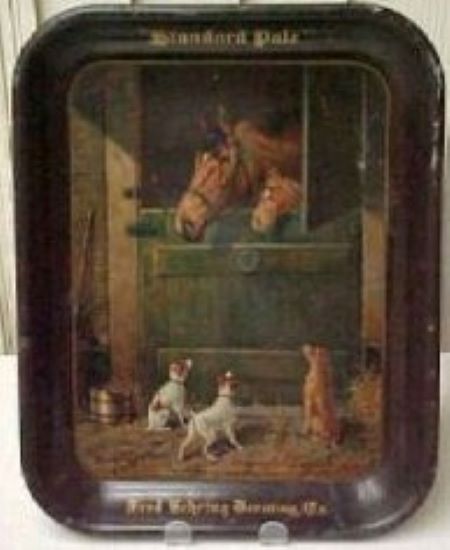The 'Stock' Exchange
The Meek Co.: No. 100 "Good Morning"
The Meek Co.: No. 100 "Good Morning"
Date: 1909 - 1912
Size: 13.25" x 13.25"
& 10.5" x 13.25"
Type: Pie
Size: 13.25" x 13.25"
& 10.5" x 13.25"
Type: Pie

Confirmed Brewer used Stock Trays
Non-Beer Related & Non-Tray Uses
General Comments
No. 100 continues the trend of Meek including at least one design a year geared toward a rural/farm audience. It must have been successful given the numerous examples, as well as the fact that it was carried over into the American Art Works catalog following the name change in December 1909. We’ve encountered several examples that carry the text “Copyright 1909. The American Art Works, Coshocton, Ohio. Successors to the Meek Co.” Some trays carry a paper label on the back, most of which are damaged. The best we’ve been able to reconstruct the text:
Good Morning Henry Stull Bright and cheerful it comes to you. Fresh and sparkly…born day. Great luck-sunny cheer it brings. The new colt looks out into the bright happy sunshine of a new day and inquiring the small dogs look up and bark out greeting "Good Morning". The picture depicts the man's business who buys it. The… symbolizes strength, the oak vitality. The mother symbolizes steadiness and trustworthiness. The dogs symbolize will and great cheer. The horse shoe symbolizes good… broom sweeps away all doubts and he who does not customer will surely kick the bucket. "Good Morning"
The image was originally created by Henry Stull (1850-1913); signature appears near the bottom left of the image and was probably exclusively acquired by Meek for commercial use. Henry Stull was a late 19th- early 20th-century Canadian-American painter and illustrator, most famous for his classy paintings of racehorses. Together with Edward Troye he was widely regarded as one of the most prominent equestrian artists of the United States. Stull was exposed to horses early in life, as his father was the driver of a horse-drawn hack. Stull wanted to be an actor and moved to Brooklyn, New York City, where he finally managed to work for a local theater company. Unfortunately, not as an actor, but as a painter of stage sets.
Stull had an interest in horse races and often took sketches at local contests. While he attended a race at Jerome Park in the Bronx, he sketched a racehorse owned by August Belmont, named Fiddlesticks. He copied his sketch to more high-quality paper and sent the end result to the editor of Sporting New Yorker. Belmont was one of the people who saw this drawing in print and was so impressed that, in 1876, he helped him get a job for the racing magazine Spirit of the Times. Stull would remain its house cartoonist and illustrator for 14 years. In the late 1870s he started painting official portraits of racehorses on commission, with many millionaire horse owners acting as his patrons. From then on, his racehorse paintings also appeared in Harper's Weekly.
The title “Good Morning” was used twice, once by Meek for this design (No. 100) and again by American Art Works in 1913 on stock design No. 132.
We have seen examples that carry a 1908 copyright date, but Sahling’s workbook records a March 1909 date for “Stock tray No. 100, Good Morning.” Because there have been a few other examples were there have been entries for the same design found a couple of months apart, we looked to see if perhaps he’d begun the design earlier in 1908 but do not find any other entries that could relate to this tray. His workbook reveals several other non-stock trays and eight different illustrations for a stock calendar between “Bertha” (No. 99) and No. 100. The likely explanation for the date disparity is that the original artist, Charles Stull, copyrighted the image in 1908 and sold it to Meek but that they didn’t get around to producing it as a stock design for trays and signs until 1909.
Size & Shape
As a tray, #100 most often appears as a square which was probably the predominant shape for Meek stock designs in 1908 and 1909. It also appears less frequently as a small, portrait-oriented oblong rectangle, which we speculate occurred later under American Art Works (that size/shape being very popular in their catalog from 1910 through 1911). We have seen a few sign versions, both tin-over-cardboard and self-framed tin.
Hager & Price
This is not a design that Hager discussed other than to place its introduction in 1909; he does include it in his catalog. As is typical, brewery examples command higher prices than non-breweries with the odd exception of a distiller here and there; however, compared to other stock designs prices are modest. Two exceptions jump out: examples for Fink’s Lager Beer and Edward L. Drewry (of Drewrys Brewing Company) went for over $1,000 several years ago.
No. 100 continues the trend of Meek including at least one design a year geared toward a rural/farm audience. It must have been successful given the numerous examples, as well as the fact that it was carried over into the American Art Works catalog following the name change in December 1909. We’ve encountered several examples that carry the text “Copyright 1909. The American Art Works, Coshocton, Ohio. Successors to the Meek Co.” Some trays carry a paper label on the back, most of which are damaged. The best we’ve been able to reconstruct the text:
Good Morning Henry Stull Bright and cheerful it comes to you. Fresh and sparkly…born day. Great luck-sunny cheer it brings. The new colt looks out into the bright happy sunshine of a new day and inquiring the small dogs look up and bark out greeting "Good Morning". The picture depicts the man's business who buys it. The… symbolizes strength, the oak vitality. The mother symbolizes steadiness and trustworthiness. The dogs symbolize will and great cheer. The horse shoe symbolizes good… broom sweeps away all doubts and he who does not customer will surely kick the bucket. "Good Morning"
The image was originally created by Henry Stull (1850-1913); signature appears near the bottom left of the image and was probably exclusively acquired by Meek for commercial use. Henry Stull was a late 19th- early 20th-century Canadian-American painter and illustrator, most famous for his classy paintings of racehorses. Together with Edward Troye he was widely regarded as one of the most prominent equestrian artists of the United States. Stull was exposed to horses early in life, as his father was the driver of a horse-drawn hack. Stull wanted to be an actor and moved to Brooklyn, New York City, where he finally managed to work for a local theater company. Unfortunately, not as an actor, but as a painter of stage sets.
Stull had an interest in horse races and often took sketches at local contests. While he attended a race at Jerome Park in the Bronx, he sketched a racehorse owned by August Belmont, named Fiddlesticks. He copied his sketch to more high-quality paper and sent the end result to the editor of Sporting New Yorker. Belmont was one of the people who saw this drawing in print and was so impressed that, in 1876, he helped him get a job for the racing magazine Spirit of the Times. Stull would remain its house cartoonist and illustrator for 14 years. In the late 1870s he started painting official portraits of racehorses on commission, with many millionaire horse owners acting as his patrons. From then on, his racehorse paintings also appeared in Harper's Weekly.
The title “Good Morning” was used twice, once by Meek for this design (No. 100) and again by American Art Works in 1913 on stock design No. 132.
We have seen examples that carry a 1908 copyright date, but Sahling’s workbook records a March 1909 date for “Stock tray No. 100, Good Morning.” Because there have been a few other examples were there have been entries for the same design found a couple of months apart, we looked to see if perhaps he’d begun the design earlier in 1908 but do not find any other entries that could relate to this tray. His workbook reveals several other non-stock trays and eight different illustrations for a stock calendar between “Bertha” (No. 99) and No. 100. The likely explanation for the date disparity is that the original artist, Charles Stull, copyrighted the image in 1908 and sold it to Meek but that they didn’t get around to producing it as a stock design for trays and signs until 1909.
Size & Shape
As a tray, #100 most often appears as a square which was probably the predominant shape for Meek stock designs in 1908 and 1909. It also appears less frequently as a small, portrait-oriented oblong rectangle, which we speculate occurred later under American Art Works (that size/shape being very popular in their catalog from 1910 through 1911). We have seen a few sign versions, both tin-over-cardboard and self-framed tin.
Hager & Price
This is not a design that Hager discussed other than to place its introduction in 1909; he does include it in his catalog. As is typical, brewery examples command higher prices than non-breweries with the odd exception of a distiller here and there; however, compared to other stock designs prices are modest. Two exceptions jump out: examples for Fink’s Lager Beer and Edward L. Drewry (of Drewrys Brewing Company) went for over $1,000 several years ago.


Click the Picture to Return to Meek & Beach Stock Catalog Page
